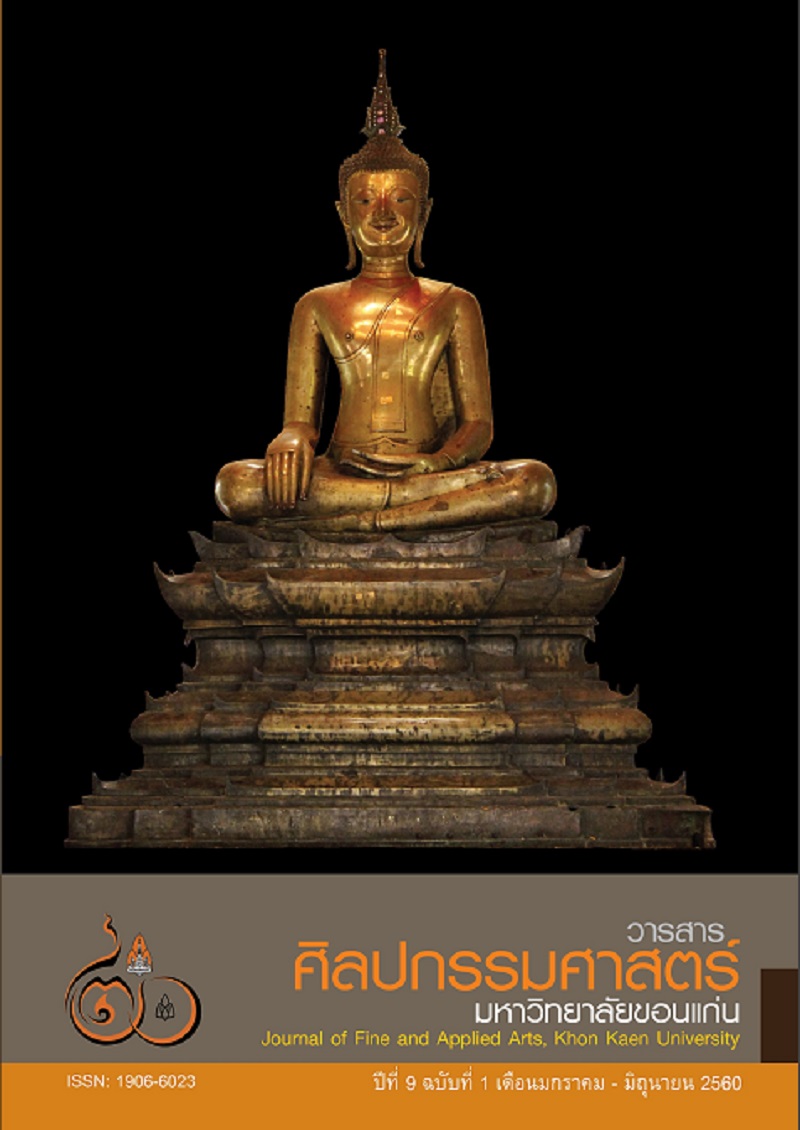พุทธศาสนากับระบบกษัตริย์ในวัฒนธรรมทวารวดีอีสาน: วิเคราะห์จากงานศิลปกรรม Buddhism and Monarchy in Isaan Dhavaravati Culture: Analysis from Art Works
Main Article Content
Abstract
บทความนี้เป็นการอธิบายให้เห็นถึงสถานภาพและตำแหน่งในระบบความสัมพันธ์ทางสังคมของกษัตริย์ในวัฒนธรรมทวารวดีอีสาน จากข้อมูลหลักฐานด้านจารึกและผลงานศิลปกรรม ด้วยการวิเคราะห์ตามกรอบแนวคิดทฤษฎีการแลกเปลี่ยนทางสังคม(Social Change Theory)
ทฤษฎีนี้ตั้งอยู่บนพื้นฐานของกระบวนการสร้างกิจกรรมเพื่อส่งเสริมความสัมพันธ์ระหว่างบุคคล สำหรับการแลกเปลี่ยนผลประโยชน์ หรือความพึงพอใจในด้านต่างๆ ที่ไม่จำเพาะแต่ผลประโยชน์ทางวัตถุ แต่ยังรวมไปถึงผลทางด้านจิตใจด้วย โดยกระบวนการสร้างความคิดหรือกิจกรรมทางสังคมนี้มีอยู่สองระดับ คือ การอธิบายถึงกิจกรรมและการกระทำของบุคคล ส่วนระดับที่สองจะเกี่ยวข้องกับสถานภาพและตำแหน่งของบุคคลที่มีผลต่อการกำหนดรูปแบบความสัมพันธ์ทางสังคม และความสัมพันธ์เชิงอำนาจ
โดยกษัตริย์ในวัฒนธรรมทวารวดีอีสาน ได้สร้างระบบความสัมพันธ์กิจกรรมด้วยการบุญทางพระพุทธศาสนาให้เป็นกระบวนการแลกเปลี่ยนทางสังคม เพื่อหวังผลต่อความพึงพอใจของทั้งผู้ประกอบการและผู้ร่วมการบุญนั้น ผ่านปูชนียวัตถุ ปูชนียสถานต่างๆ ที่เป็นผลงานศิลปกรรม อุทิศถวายเป็นพุทธบูชา และมีความคาดหวังต่อโลกหน้าในศาสนาพระศรีอาริย์ ทั้งพระพุทธรูป พระพิมพ์ สถูป เจดีย์ เสมา ธรรมจักร ประกอบกับเนื้อความจากจารึกที่พบในวัฒนธรรมทวารวดีอีสาน สะท้อนให้เห็นแบบแผนของระบบกษัตริย์ในวัฒนธรรมทวารวดีอีสานได้เป็นสองนัยคือ คติเกี่ยวพระโพธิสัตว์ เพื่อบำเพ็ญปฏิบัติการบุญสร้างสมบารมี ให้ความอนุเคราะห์ต่อประชาชนทั้งความสุขทางกาย ความสงบทางจิตใจ และคติพระจักรพรรดิราช เพื่อการขยายดินแดนทางอาณาจักร สำหรับการปกครองแผ่นดินโดยธรรม
This article is an illustration and position of the system of social relationship of kings in Isaan Dharavati culture. The data was obtained from inscribed evidences and art works. The analysis was based on the Social Change Theory Framework.
This theory was based on the process of organization of activities to promote interpersonal relationship to promote reciprocity or any types of satisfaction – not only in terms of material but also spirit. There were two levels of the idea construction process or social activities which explained the activities or actions of people and the second level related to status and position of the people that had an effect on determination of social relation pattern and power relation.
Kings in Isaan Dharavati culture had constructed activity relation system with Buddhist ceremony, so it became social exchange process that expected satisfaction of organizers and attendants of the ceremony. The satisfaction was presented through sacred objects or sacred constructions in the form of arts dedicated to Buddha. There was also expectation towards the next life in the era of Sri Arayuga. Buddha images, Buddha tablets. Stupas, Chetiyas, Buddhist boundary mark, Dramachakra, and contents from the inscriptions found in Isaan Dharavati culture reflected the pattern of Monarchy in Isaan Dharavati culture by two aspects which were the lore of Bodhisattva who practiced to accumulate merits and virtues and helped people so they achieved physical and spiritual happiness, and lore of emperors who expanded the land of the kingdom for the governance of the land with moral.
Article Details
Content and information in articles published in the Journal of Fine and Applied Arts of Khon Kaen University is regarded as the opinion and sole responsibility of the author(s) directly; therefore, editors are not obliged to agree to or share any responsibility with regard to the content and information that appears within these articles.
All articles, information, content, image, etc. that have been published in the Journal of Fine and Applied Arts of Khon Kaen University is the copyright of the Journal of Fine and Appllied Arts of Khon Kaen University. Any person or organization who wishes to distribute all or parts of the articles for further dissemination or other usage must first receive permission from the Journal of Fine and Applied Arts of Khon Kaen University before proceeding to do so.


